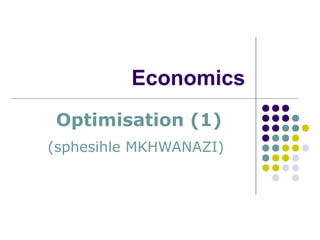Lecture 1 optimisation & minimisation
- 2. References in textbook ’ü¼Micro Management Economics ’ü¼Section A Pages 2-13 ’ü¼Workbook section
- 3. Concepts to be covered in lecture ’ü¼ 1) Unconstrained optimisation. ’ü¼ 2) Constrained optimisation. ’ü¼ 3) Linear programming. ’ü¼ Primal problem. ’ü¼ Shadow prices. ’ü¼ Profit maximisation. ’ü¼ Cost minimisation.
- 10. Corner Point Combination Cost a 2.5A +0B ’┐Ī 1250 b 5/3A + 2/3B ’┐Ī 1233 c 0A + 4B ’┐Ī 2400 The lowest cost is ’┐Ī 1233 and it requires 5/3 cases of type A and 2/3 cases of type B per production run to be produced. Contribution per one unit of constraint (shadow prices) 10 VHR + 20 VM + 10VC (HR = labour component, M = material, C = production capital and V = shadow price) and 4VHR + 10VM + 5VC = 500 5VHR + 5VM + 4VC = 600 The slack variable is production capital 4 VHR + 10VM = 500 and 5 VHR + 5VM = 600 Simultaneous solving for two unknowns result in: VHR = 116 2/3 & VM = 3 1/3 Every one additional HR ŌĆō input will add ’┐Ī 116.66 to total cost and one additional unit of material will add ’┐Ī 3.33 to total cost.









